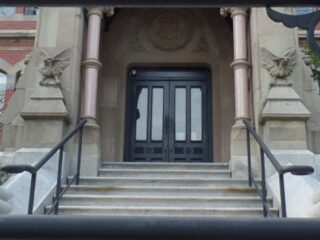By Christina Lewis
Margaret Mitchell admired people who had gumption, people who fought their way through hard times triumphantly and came out survivors. She said that if her novel, Gone with the Wind, had a theme it was survival, “I wrote about the people who had gumption and the people who didn’t.”
Margaret Munnerlyn Mitchell was born on November 8, 1900 in Atlanta, Georgia where she lived all of her life. Margaret was a writer from the time she could hold a pencil and a storyteller almost as soon as she could talk. She would gather her friends around her as she told them tales. Margaret enjoyed writing stories and plays and relished in the telling of her tales. She wrote and produced plays and cast herself and her friends in the parts. From an early age, Margaret took an interest in Atlanta’s history and the Civil War. She had an enduring connection and great love for Atlanta. She enjoyed discovering the history of Atlanta and Peachtree Street, where she lived. Parties and family gatherings supplied her with much Civil War history that she would later use in the writing of Gone with the Wind. Margaret recalled, “When we went calling, I was usually scooped up onto a lap – told that I didn’t look like a soul on either side of the family – and then forgotten for the rest of the afternoon while the gathering spiritedly refought the Civil War. Cavalry knees had the tendency to trot and bounce and jog in the midst of reminiscences and this kept me from going to sleep, fortunately for Gone with the Wind.”
Margaret’s interest in reading and writing came from her mother’s encouragement to read the classics and write her own stories. When Margaret was six-years-old her mother taught her the importance of having an education, both classical and practical. Mrs. Mitchell made an impression on her daughter when she explained to Margaret how precarious life is and the only thing that will save her is what she has in her head. “Well, I never could learn the multiplication table above the sevens but I was frightened and impressed enough by her words to learn enough rhetoric to land a job on a newspaper some years later.” By the time Margaret was eleven she had gone through Shakespeare, although that could be because of the small amount of money Mrs. Mitchell paid her for the reading of each play. Margaret enjoyed reading Sir Walter Scott and Charles Dickens, The New York Sun to which her father subscribed, and several children’s magazines they received at home. Margaret wrote spooky ghost tales and short skits that often had violent plots, the plays were performed in full costume and Margaret usually cast herself as the hero. One time, Margaret dramatized “The Traitor” by Thomas Dixon, she was scolded and received a spanking from her father for plagiarism. She quickly learned not to take what wasn’t hers since plagiarism was considered the same thing as stealing.
Margaret’s mother was a devout Catholic with proud Irish roots and she instilled that pride in her children. Mrs. Mitchell was one of the founders of the League of Women Voters in Georgia; she was very outspoken about women’s rights and would often take Margaret to suffragette rallies. Her argument for women’s rights was based on economic justice. Mrs. Stephens had inherited some property and she objected to paying taxes if she was not given the right to vote on how the money should be spent.
Much like her heroine Scarlett O’Hara, Margaret enjoyed social events and being the center of attention. She was a lively and spirited girl with a great sense of humor. She was flirtatious and charming and always had a long string of beaux. Margaret graduated from Washington Seminary in June 1918 and made plans to enter Smith College in Massachusetts. That summer she met and fell in love with Lt. Clifford Henry. The two soon became engaged and Margaret was to experience the first of several heartbreaks when she received word later that year that Clifford died in battle. That fall Mrs. Mitchell took Margaret to school and saw her settled in. She said goodbye to her mother at the railway station not knowing it would be the last time she would see her mother alive. Mrs. Mitchell died from complications with pneumonia and the flu on January 25, 1919. After the funeral Margaret returned to Smith to finish out her freshman year, she was not at all happy with her grades and believed herself a failure because she had not done better. Margaret did not return to school the following year, she stayed home to take care of her father and at the young age of nineteen became the mistress of the house and agreed to make her formal entrance into Atlanta society.
Soon after her debut, Margaret shocked the stiff necks of society when during a ball Margaret and a young man performed the scandalous Apache dance. Margaret soon learned what her social standing was when she was snubbed by the Junior League and not asked to be a member again the following year.
Shortly after, Margaret met John Marsh and Berrien Kinnard Upshaw and they both vied for her attention. Upshaw would win Margaret’s affection and the two become engaged in spite of her father and brother’s disapproval. On September 2, 1922 Margaret and Upshaw were married, John Marsh was the best man. But the marriage was doomed from the start, Upshaw was a violent and dangerous man, and he left only a few months into the marriage.
Margaret’s love of Atlanta, her interest in the happenings in town, and her desire to be a writer brought her to Angus Perkerson’s office in December of 1922. Margaret went to see the editor of the Atlanta Journal Sunday Magazine about becoming a feature writer. He decided to give her a try and over the next four years Margaret wrote 129 feature stories about everything going on in Atlanta. She learned a lot about writing and about Atlanta during her time at the Journal. Margaret believed that working on the paper was a liberal education, “If more women, when they were girls, were in a position to see – as a newspaper girl is -the inside of jails, the horrible things Travelers’ Aid discovers, the emergency rooms of Grady Hospital and those sad, desolate sections which used to be fine homes but now are rookeries and rabbit warrens – if more people knew the sad things and the horrible things that go on in the world, there would be a darned sight less complacency and probably not so many of those sad sights and horrible things.”
In 1924, Margaret’s social life began to pick up, she had new friends from the paper, was granted a divorce from Upshaw on the grounds of cruel treatment and began a quiet courtship with John Marsh. In 1925, John and Margaret became engaged and on July 4, 1925 were married at the Unitarian-Universalist Church on West Peachtree Street. John and Margaret made their home in a tiny apartment she affectionately called “the dump.” The apartment was located in an old brick house that had been converted into an apartment building, and is now the home of the Margaret Mitchell House and Museum, founded by Mary Rose Taylor, who is the Executive Director. Since 1990, she has tirelessly made an effort to save the house where Gone with the Wind was written and in 1995 received a $5 million charitable contribution from Daimler-Benz, to purchase the property and restore the house as a museum.
Margaret left the Journal on May 3, 1926 to devote her time to being a wife to John, although she did continue to freelance for the Journal as she took over the “Elizabeth Bennet Gossip Column.” During this time she began writing fiction and she saw it as a private matter, therefore she discussed it with no one but John, who soon became her editor. Before writing Gone with the Wind, Margaret began a novel of youth in the 1920’s but abandoned the story after thirty pages, which was eventually burned years later at Margaret’s instruction. Margaret did go on to complete a novella “‘Ropa Carmagin” which she instructed her secretary to read and then file away. The secretary found the story to be fascinating but it too was destroyed by either John or Margaret. Margaret spent the summer of 1926 reading, writing and doing research at the Atlanta public library.
In early autumn, Margaret broke her ankle and had to give up writing the column. Confined to her small apartment and at first bed-ridden then later on crutches, John brought home piles of library books for her. And late in 1926 when it appeared that she had read every book in the library, John said to her that she would have to write a book herself if she were to have anything more to read. So early in 1927 Margaret sat at a spindly table in an alcove of the front room with her Remington portable typewriter and pile of paper – and began work on Gone with the Wind. When questioned by friends Margaret would only say that she was engaged in a “piece of writing.” With no deadline and the story nearly complete in her head she started down the long path that would eventually take ten years to finish the world’s best selling book, second only to the Bible. Margaret wrote her story by chapters, stored them in manila envelopes, some with scribbles and slips of paper with changes stuffed in. She stacked these envelopes in various places around the apartment. The stacks slowly began getting taller, gathering dust and dirt over the years. Gone with the Wind was a love story as well as a fictionalized account of Civil War history. Margaret spent years perfecting the historical facts of the Civil War and Reconstruction.
By the end of 1929 Margaret had somewhat completed the book, although it lacked an opening chapter and other chapters were incomplete. She worked on the book a little more over the next two years, and by 1932 the stacks of envelopes found a new home in the closets of the front room. Margaret and John moved to a larger apartment that year and she found storage space for the novel she felt “would probably never be worth seeing.” Margaret wasn’t sure whether or not her book had merit or if it would be worth publishing. Like so many other writers, she had little confidence in herself and her work. Then in 1935, Margaret met Harold Latham, an editor for MacMillan, while he was in Atlanta on a scouting trip for new literary talent. Latham had heard about Margaret from another editor at MacMillan, Lois Cole, who was a friend of Margaret’s. Margaret was in charge of showing Latham around town and introducing him to new writers. But when he asked to see Margaret’s manuscript she replied that she had nothing to show. Margaret was so full of self-doubt about her novel she was afraid to let anyone see it, not to mention the messy condition it was in. On the last evening of Latham’s visit to Atlanta an acquaintance of Margaret’s, who had heard about Latham asking to see her novel, casually remarked that someone like Margaret could not write a successful book because she was not the type. That comment made Margaret so angry she hastily retrieved her manuscript from its many resting places and rushed to Latham’s hotel in time to hand it over. He had to buy a cheap cardboard suitcase just to carry the whole thing back to New York with him. As Latham read the novel on the trip home he knew it was “something of tremendous importance.” And after many hard months of changes, revisions and relentless fact checking, Gone with the Wind was officially completed on January 22, 1936.
The book experienced huge success even before the first copy hit the stores. It received rave reviews, was selected as the July Book of the Month and the movie rights were sold to David O. Selznick for $50,000, and at the time was the highest amount ever paid for movie rights. The chaos soon began for Margaret and she was not prepared for it nor did she know how to handle it. With the phone ringing off the hook, people calling at all hours, and someone always at her door – the pressure was too much for Margaret. The fan letters poured in by the thousands and Margaret spent the majority of her time personally answering these letters, many times writing several pages of response. Maybe it was all of this chaos and the business affairs that took up most of her time that kept her from writing another novel. Or maybe it was the fear that she would never write another book with the same success and she would not feel like a real author, just a first-time writer who got lucky. But she never did write another story.
The official release date was set for June 30, 1936 and the novel had pre-sold more than 50,000 copies. Even with all of the success of Gone with the Wind, Margaret was extremely proud when she received an honorary Master of Arts Degree from Smith College and the Pulitzer Prize in 1937. December 15, 1939, three years after her novel was published, the much-anticipated premier of the movie was set to take place in Atlanta. The city pulled out all the stops and the premier was a grand affair. Gone with the Wind won Best Picture of 1939.
By 1946, Gone with the Wind had sold 3,713,272 copies in the U.S. Margaret became a legend in her own time and although she was a woman of small stature, Margaret did not appear small; she had a huge personality and a wonderful way with words. Early in 1949 she felt the pressure of business was becoming lighter and perhaps she would now have time to think and write. She had spoken of a novel or two, but that would never happen.
On August 11, 1949 Margaret and John were on their way to see a movie, as they were crossing Peachtree Street, an off-duty cab driver came speeding down the road. For some reason Margaret stepped back, away from John, the driver slammed on his brakes but was unable to avoid hitting her. She was struck down near the curb she had just left. Margaret held on for five days, but died on August 16th, never regaining consciousness.
When Margaret Mitchell died the people of Atlanta felt as though they had lost a member of the family. Margaret Mitchell entertained and enchanted the world with her admirable love story. She was there to lend a helping hand to those in need by giving her time and energy to sick families and friends, volunteering for the Red Cross and campaigning for the war. She was a champion of human rights who inspired the building of the first black hospital and she worked with Morehouse College to anonymously establish fifty scholarships for African-American medical students.
By late 1965, Gone with the Wind had sold more than 10,000,000 copies and had been translated into twenty-five languages in twenty-nine countries. The impact Gone with the Wind had and still has on the world is immeasurable. Something Margaret could never have predicted and probably never even dared to hope for. With Gone With the Wind Margaret brought a promising message to all people – “Tomorrow is another day.”
Christina Lewis is a freelance writer and owner of two websites for children, KidsBookshelf.com and GreatSitesForKids.com.
Margaret Mitchell House and Museum
990 Peachtree Street
Atlanta, Georgia 30309
404-249-7015
http://www.gwtw.org
A not-for-profit organization founded in 1985 to save and preserve the house where Margaret Mitchell lived and wrote the book “Gone With the Wind.”
According to Mary Rose Taylor, Executive Director, “Gone with the Wind has had a profound impact on people’s lives as a piece of American literature. When visitors come to the Margaret Mitchell House, they bring stories of how Gone with the Wind helped them cope with the ravages of war in their own land – a young mother from Ireland, a student from Croatia, a family from Bosnia. As long as there are wars, Gone with the Wind will continue to inspire a peoples’ love of the land and home.”









1 comment
I was told Margaret Mitchell and mother might be related to me. What was Margaret Mitchell mother maiden name? Was it Geoghegan?